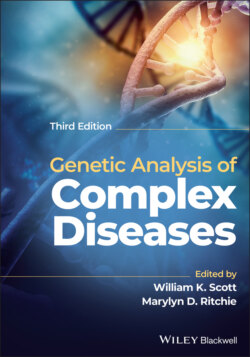Читать книгу Genetic Analysis of Complex Disease - Группа авторов - Страница 76
Twin and Adoption Studies
ОглавлениеTwin and adoption studies can be quite useful as they provide an opportunity to tease apart the role of genetics and a common familial environment. The most difficult aspect of these types of studies is obtaining reasonable sample sizes. This is especially true in the United States where twin, adoption, and disease registries are less common than in European countries.
The premise of twin studies is the comparison of the disease concordance in monozygotic (MZ) with dizygotic (DZ) twins. Since MZ twins share 100% of their genetic make‐up and DZ twins share on average 50% of their genetic make‐up, a greater disease concordance in MZ compared with DZ twins is consistent with the involvement of genetics. An advantage of this approach is that it controls for a common familial environment, but this is generally only applicable for exposures during childhood. It may not entirely control for prenatal exposures because the twins, especially DZ, may not have shared placentas, chorions, and amniotic sacs. However, the intrauterine and extrauterine environments are generally more similar for DZ twins than siblings. It is even less likely that adult exposures are similar among the twins, especially if they reside in different geographic locations. Other possible confounding variables controlled for in the twin study approach include age and sex (provided same‐sex DZ twins are utilized). However, keep in mind that for a condition with variable age of onset, it may be necessary to follow the twins for several years in order to conclusively determine that a set of twins is concordant or discordant for the condition. But most importantly, prior to beginning any twin study, one must determine the zygosity of the twins, as misclassification can have a devastating effect on the outcome of the analysis (Ellsworth et al. 1999). Often families will know the zygosity of the twins, but it is prudent to determine this experimentally via genotyping.
Table 3.2 below shows examples of concordance rates that might be observed under various disease etiologies. In practice, the results will not be easily interpreted for complex disorders, much like the results obtained in the last row of this table. In general, however, if the frequency in concordance is greater in MZ compared with DZ twins, it is accepted as evidence for at least a minor role of genetics in the disease etiology.
Adoption studies can also be used to examine the evidence for genetic versus common familial environmental factors. In this approach, cases are ascertained and then the frequency of the condition in the biological parents is compared with the frequency of the condition in the adoptive parents. As shown below in Table 3.3, a higher disease frequency in biological parents argues for the presence of genetic factors, while a higher disease frequency in the adoptive parents argues for the presence of a common familial environmental factor. A variation on adoption studies is the adoptive‐twin approach where twins who have been reared apart are examined to determine if genetics (high concordance rate) or environment (low concordance rate) plays a role in the disease etiology.
Table 3.2 The association between disease concordance rates in twins and disease etiology.
| Frequency of disease concordance in twins | ||
|---|---|---|
| MZ (%) | DZ (%) | Possible etiology |
| 85 | 85 | Common familial environment |
| 100 | 25 | Mendelian recessive genetic factor |
| 100 | 50 | Mendelian dominant genetic factor |
| 63 | 17 | Genetic and environmental factors? |
Table 3.3 Adoptive studies and disease etiology.
| Frequency of disease in parents | ||
|---|---|---|
| Biological (%) | Adoptive (%) | Possible etiology |
| 85 | 4 | Genetic factors |
| 4 | 85 | Common familial environment |
While adoption studies are simple in theory, in reality, they are quite difficult to carry out. Achieving the necessary sample size can be challenging because of the need to identify the biological parents. Moreover, children are often placed in demographic environments similar to that of the biological parents, making it difficult to ensure that one can distinguish between genetics and environment. However, when these issues can be overcome, this approach can provide critical information regarding the etiology of complex traits. For example, this approach has been used to demonstrate that familial aggregation of multiple sclerosis is due to genetics and not a shared environment (Ebers et al. 1995), and to differentiate the role of genes and environment on various psychological measures (Bouchard, Jr. et al. 1990).
